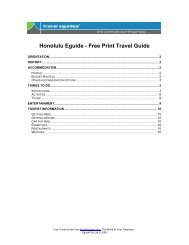Australia Eguide - Travel Guides
Australia Eguide - Travel Guides
Australia Eguide - Travel Guides
Create successful ePaper yourself
Turn your PDF publications into a flip-book with our unique Google optimized e-Paper software.
29<br />
that inland one finds dry, dusty conditions unsuitable for much agriculture and only very<br />
sparsely populated. Snow lies only in a small area around the border of New South Wales<br />
and Victoria where the nation’s highest mountains are to be found, and also in some parts<br />
of Tasmania.<br />
The northern parts are quite different in climate, for they have not summer and winter,<br />
but tropical Wet and Dry Seasons. Those unfamiliar with such a climate often<br />
misunderstand the temperatures which accompany such seasons. The Wet is the hotter of<br />
the two, while the Dry is pleasantly warm, but not overpoweringly hot. In between the<br />
two is sandwiched a season generally known as the Build-Up, when humidity gradually<br />
increases until it reaches almost 100% and temperatures too become higher and higher,<br />
reaching the highest levels of the whole year, until one day the heavens open and general<br />
relief is felt that the Wet has at long last started. If there is a season to avoid, it is the<br />
Build-Up.<br />
The Wet typically lasts from December until March, the Dry from April until August and<br />
the Build-Up from September until November. Typical maxima might be 33ºC in the<br />
Wet, 28ºC in the Dry and 36ºC in the Build-Up. This type of climate is coastal. As one<br />
moves inland rainfall decreases and day temperatures tend to be higher.<br />
Most people believe that the best time to be in the southern half of <strong>Australia</strong> is during the<br />
summer or autumn, that is December until May, and the best time to be in northern<br />
<strong>Australia</strong> is during the Dry, that is April until August. The torrential downpours at the<br />
start of the tropical Wet Season, for example, are awe-inspiring sights. Just take the<br />
weather as it comes and enjoy it.<br />
However, if your main purpose is lying on the beach, it is worth noting that from July<br />
until November you would be better off in the northern part of <strong>Australia</strong>, and also that the<br />
tropical Wet Season will limit access to places off the main routes. Also note that the<br />
north and north-west are prone to some very fierce cyclones during the Wet.<br />
On the topic of climate, some of the <strong>Australia</strong>n records are interesting and surprising. For<br />
example, which capital city has recorded the highest temperature When asked this<br />
question, many people guess Darwin. However, in fact all of the other seven capital<br />
cities, even Hobart (40.8ºC, 105.4ºF), have recorded higher temperatures than Darwin’s<br />
40.5ºC (104.9ºF) on 17th October 1892. The capital city with the highest temperature is<br />
actually Adelaide with 47.6ºC (117.7ºF) on 12th January 1939. The highest temperature<br />
ever recorded anywhere in <strong>Australia</strong> was 53.1ºC (127.6ºF) in Cloncurry, Queensland on<br />
16th January 1889. In recent years, the validity of this record has been challenged, since<br />
it was a while ago and the equipment used would not satisfy today’s standards. However,<br />
most people still regard this as the record. The Meteorological Office, however, is<br />
prepared to vouch only for the 50.7ºC (123.3ºF) recorded in Oodnadatta, South <strong>Australia</strong><br />
on 2nd January 1960.<br />
Free from <strong>Travel</strong><strong>Eguide</strong>s.com Online <strong>Travel</strong> Information.<br />
©2008 <strong>Eguide</strong> Pty Ltd




